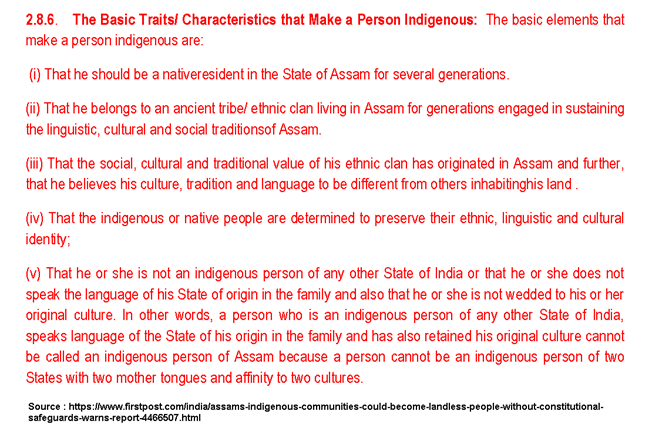Brahma Committee Report Stresses on the Danger of Illegal Immigration to Land Holdings

Image Courtesy: Assam News Network
The Committee for Protection of Land Rights of Indigenous People of Assam had submitted its final report on January 18. However, it appears that due to the differences of opinion betweenamong the committee members led to two reports being submitted. The report submitted by former Chief Election Commissioner Hari Shankar Brahma, was submitted to the Assam CM, Sarbananda Sonowal. However, the other report submitted by former Education Secretary Rohini Baruah was given a 'cold shoulder'. Baruah eventually submitted his report by post. The two reports do not differ much in contents, though the report submitted by Baruah was more forceful in assertingasserted more on the threat to land holdings posed by illegal immigrants. The differences in opinion, as per reports, appear to be driven by how much the immigration issue should be stressed on.
What the two reports agreed upon was that some laws concerning land holdings were outdated, while others were not being properly implemented. The issues identified in the recommendations were:
- Immigration
- Eviction of encroachers
- Agricultural income
- Land reforms
On the issue of immigration, both the reports agreed that any meaningful redistribution of land and land reforms in Assam can only be effected only after the National Register of Citizens (NRC) is updated, India enters into a repatriation treaty with Bangladesh – , sealing the international borders along Assam, Meghalaya, Tripura and Mizoram, and foreigners are detected and repatriated. The problem here is that it places India in a Ccatch- 22 situation. On one hand, if India were to aggressively push for a repatriation treaty with Bangladesh, the country may turn to other more accommodating business partners. Whereas, if India were to continue doing nothing on this issue, itthey may help kindle Assamese resentment towards New Delhi.
The committees have recommended evicting encroachers from forest land, land in tea estates, char land, temple land, sattra land, and waqkf land. They had noted that encroachers faell into two categories:, the illegal immigrant encroachers, and those internally displaced by floods and erosion. The reason for evicting encroachers from designated forest land as well as char land iswas based on ecological factors. Chars are riverine islands made of alluvial silt deposits. Chars are offall under three types:, permanent islands, semi- permanent islands, and temporary islands. The committee recommended evicting all people from the temporary chars. The semi- permanent chars could be settled and distributed if they do not get washed away after 4four years. The permanent chars were recommended to be a part of the land for the government to distribute.
The reports recommended evicting encroachers in tea estates. Interestingly, the tea estates only have usufructuary rights over the land held by them. The land is actually vested in the government. However, the estates are not cultivated entirely, and a lot of land is actually forested. The committee recommended amending the law to transfer the remaining land back to the government, if not cultivated for four years after the tea estate occupies it. Regarding the land held by religious trusts, the committee recommended evicting encroachers from land held by sattras and temples. On the other handHowever, concerning the wakf property the committee recommended setting up a waqkf board constituting of indigenous Mmuslims to deal with the waqf property. The board should oversee the registration of waqkf properties and ensure that they are used for their intended purpose.
On the issue of agricultural income, the reports found that though around 80 per cent% of Assamese people were agriculturalists, the share of agriculture in the state's GDP was negligible. To this end, the recommendations were to improve cold storage facilities, ensure adequate access to seeds and equipment, carry out massive educational programs concerning agricultural practices, and work ethic. As well asIt also talked about encouraging collective farming and multi-cropping.
On land reforms, it was recommended that agricultural land distributed by the government should be one the basis of 5 bighas (roughly 2 acres) per person, rather than the 8 bighas (roughly 3 acres) currently mandated by law. While the existing law concerns distributing land to the landless, the committee recommended including people with marginal holdings so that they can receive land up to 5 bighas. The caveat being that all the land to be redistributed should be allocated to indigenous people only. This caveat, however, does not apply to the categories of persons covered under Chapter X of the Assam Land and Revenue Regulation, 1886 (ALRR). This provision allows certain classlasses of persons to receive and hold land – plains tribals, hill tribals, tea garden tribals, Santals, Nepali cultivator-graziers and Scheduled Castes. However, the committee also recommended amending this provision by inserting 'indigenous' before 'Scheduled Castes'. Summing up, the recommendation concerning land reform is concerned solely with ensuring that agricultural land does not get transferred from a tribal to a non-tribal. From a protected class of persons under Chapter X of the ALRR to a non-protected class, and from an indigenous person to a non-indigenous person.
What makes the reports most interesting, is that they attempt to legally define 'indigenous'. After going through the dictionary definition of 'indigenous', the UNO's definition, as well as taking into account the views of the various stakeholders involved, they recommended the following characteristics:

What makes this definition interesting is that if this definition is adopted, apart from restricting the rights of citizens from other states in India concerning agricultural land in Assam, it may adversely impact Assam's Bengali- speaking population in the Barak Valley. On the other hand, since the Barak Valley historically formed a part of Sylhet, the Sylheti language may see a revival. The Bishnupuria Manipuris in Assam too may face difficulty, unless it is accepted that the region they inhabit was once a part of the old kingdom of Manipur.
However, until the report is placed before the assembly it is likely to sit on a shelf, gathering dust. With the NRC in the process of being updated, and Assam along with other Northeastern states, is opposing the Citizenship Bill, all these three issues have come to be intertwined. Because at the end of the day, for communities whose identity is their land, being landless is social death.
Get the latest reports & analysis with people's perspective on Protests, movements & deep analytical videos, discussions of the current affairs in your Telegram app. Subscribe to NewsClick's Telegram channel & get Real-Time updates on stories, as they get published on our website.
























